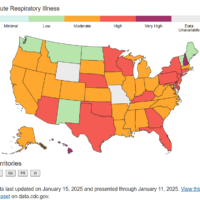(Editor’s note: An earlier version of this story misstated the metric used by the Institute for Health Metrics and Evaluation at the University of Washington to determine when a hospital is under “extreme stress.” It is the ratio of COVID-19 hospitalizations to total inpatient beds. This story has been updated.)
As the number of COVID-19 cases across Kentucky continues to grow, many hospitals have had to reduce services and make adjustments to accommodate an increasing number of patients. At Jennie Stuart Medical Center, frontline health care workers have been navigating a constant influx of coronavirus patients for months.
Hospital-level data released by the federal government on Monday show the toll the pandemic is taking on Hopkinsville’s hospital.
From Dec. 4 through 10, 36% of hospitalized adult patients at Jennie Stuart had COVID-19 — the ninth highest coronavirus patient ratio in the state. St. Elizabeth Ft. Thomas Hospital was the highest, with 61% of its patients being treated for the virus. During the two weeks prior — from Nov. 20 to Dec. 3 — Jennie Stuart’s coronavirus patient ratio reached a record high of 48%, with nearly half of all adult patients in the hospital being treated for COVID-19.
The ratio of COVID-19 to total beds can show how much strain a hospital is under. According to a framework developed by the Institute for Health Metrics and Evaluation at the University of Washington, when more than 20% of inpatient beds are occupied by coronavirus patients, it puts a hospital under “extreme stress.” For three of the last four weeks, Jennie Stuart has been at that level. From Dec. 4 through 10, 16% of total beds were occupied by COVID-19 patients, according to the data. During the three weeks prior — from Nov. 13 to Dec. 3 — the ratios were 20%, 23% and 22%.
Patients being treated for the virus require significantly more resources than others — specifically, staffing resources — so, having high levels of COVID-19 patients can present unique challenges, Beth McCraw, the hospital’s vice president of nursing and clinical services, told Hoptown Chronicle.
“These patients do tend to deteriorate very quickly … and so, we need to be able to respond very quickly,” McCraw said. “So, some of the things that we’ve done is we’ve adjusted our nurse-patient ratios. In some ways, we’ve been able to adjust them down a little bit. But of course, we’re overwhelmed with a bunch of surges and that really strains our nurse-patient ratio and, at times, nurses have to take more than what we would really want them to take.
“[It’s] just such a heavy load. [It’s] just such an acute type of situation that a lot of these patients are in.”
For regular hospital floors, a typical patient-to-nurse ratio is seven-to-one. In areas of the hospital where patients are sicker, that ratio goes down. For the intensive care unit, it’s two-to-one. In the progressive care unit, which is a step-down unit from the ICU, it’s four-to-one.
“If push comes to shove, my ICU nurses, if we got a huge surge, would have to take more than the two-to-one ratio,” McCraw said. “So that’s how we’ve included that in our surge plan.”
Jennie Stuart ICU numbers reveal further strain
According to IHME’s framework, intensive care units that have 30-59% of patients with COVID-19 are considered under “high stress.” Those with more than 60% are considered under “extreme stress.”
From Nov. 6 to Dec. 3, approximately 42% of patients in Jennie Stuart’s intensive care unit were being treated for COVID-19. For two weeks in early October, coronavirus patients comprised more than 90% of those in the hospital’s ICU.
Mitigation efforts aim to maximize resources
Hospital administrators like McCraw have had to find ways to maximize resources under the often crippling weight of the pandemic.
Within the last few weeks, Lexington hospitals have asked non-COVID patients to avoid the emergency room; Vanderbilt University Medical Center has deferred select non-emergency procedures; Deaconess Health System in Evansville has been forced to defer some admissions as its ICUs near capacity; and Baptist Health Madisonville issued a letter asking the community to help limit the virus’s spread.
On Friday, Jennie Stuart also issued an open letter to the community urging the public to take extra measures to be diligent in the fight against coronavirus in order to avoid a “situation where hospitals are full.”
At Jennie Stuart, mitigation efforts have included asking and incentivizing employees to work extra shifts, adjusting nurse-to-patient ratios, hiring additional health care workers, constantly evaluating elective procedures and redeploying staff to other areas of the hospital, McCraw said. They’ve increased the number of non-licensed employees — like nurse techs and certified nursing aides — in order to provide frontline doctors and nurses with support. Additional paramedics have also been hired to help in the emergency department.
“You might typically rely on just having a whole floor of RNs or LPNs and maybe just a few certified nurse aides,” McCraw said. “Now, because of just … not being able to really recruit as quickly as we need to for nursing to cover this, we’re really starting to work through that process. How can we work differently and still provide the support that we need to provide?
“We’re at the point where we’re having to try to bring in some travel nurses. The problem with that is they’re not readily available either.”
The hospital’s careers page on Wednesday included 65 clinical job openings. Several registered nurse and respiratory therapist positions offer $10,000 sign-on bonuses.
As hospitals across the state near capacity, more challenges arise
As a short-term, community hospital, it is common practice for Jennie Stuart to transfer heart attack and stroke patients, as well as those with specialized surgeries and conditions, to other hospitals in the region, hospital spokeswoman Selina Staub confirmed.
But as those facilities also near capacity, it has presented more challenges locally, McCraw told Hoptown Chronicle.
“What we’re seeing is everybody is struggling right now with capacity,” McCraw said. “And so, every transfer is being looked at very closely when we call, when there’s a higher level of care that’s needed, and so that’s been a challenge.
“We have had a few instances where people have had to stay planted in our emergency department until the hospital that’s receiving the patient … they have an available bed. And so it does get very challenging, and so we’re trying to work, trying to work among our own staff, our medical staff to try to identify what’s the best process if we get to a point and we have somebody and we can’t get them somewhere.”
Efforts have included compiling a list of hospitals within a three-and-a-half-hour radius of Hopkinsville, which is about 30 minutes farther than the hospital typically sends patients.
Since layoffs, frontline health care workers have returned
As the country braced for a surge in hospitalizations within the first month of the pandemic, Gov. Andy Beshear in March asked hospitals throughout the state to cease elective procedures as part of a broad mitigation strategy to curb the spread of COVID-19.
The measures — coupled with the fact that many began to postpone elective and even urgent visits in order to avoid health care settings as the novel coronavirus spread across the country and the globe — resulted in decreased patient volume and surgical revenue, prompting Jennie Stuart Medical Center to lay off nearly 250 employees.
“The continuing spread of COVID-19 in the communities we serve requires that we now take urgent action to preserve our operational and financial strength to endure the duration of this battle,” Jennie Stuart CEO Eric Lee said at the time of the announcement, noting the move was made to ensure the hospital’s stability over the course of the pandemic and “secure the key clinical personnel on the front lines of this battle.”
In May, as restrictions were lifted, the hospital began to bring back some of those workers. Since then, nearly all of the hospital’s frontline clinical staff have returned, McCraw said.
“Any staffing shortage we have is not in response to any layoff that occurred early in the pandemic, those clinical folks, as a general rule, have been brought back,” she added.
The ‘beginning of the end’ of the pandemic
On Monday, as physicians, nurses and other frontline health workers at three Kentucky hospitals were among the first to receive the COVID-19 vaccination, Beshear proclaimed the milestone marked “the beginning of the end of COVID-19.”
Early doses of the vaccine will be limited in supply and immunization will begin with nursing home residents and frontline health care workers, Dr. Steven Stack, the state health commissioner, has explained. From there, as vaccine shipments continue, Kentucky will immunize all health care (including oral health) workers and first responders, followed by students and employees in K-12 schools.
When determining the vaccine distribution plan, a top priority was reducing hospital capacity across the commonwealth.
“When someone in a long term care facility contracts COVID, oftentimes they need hospitalization and the amount of resources in the hospital significantly greater than for many other patients,” Beshear said last week. “So this priority also gives us increased hospital capacity by freeing up a doctor to see more patients than she or he otherwise would have had the opportunity to do. So if you don’t see this as just the right thing and the moral thing, understand it’s something that provides more hospital capacity.”
However, those effects won’t be immediate and health officials have urged members of the public to be vigilant, especially over the holiday season.
Beshear said Tuesday that, with the vaccinations of residents and staff in long term care facilities, it could still be a month before the state sees a decreased burden on hospitals.
Julia Hunter is the engagement editor for Hoptown Chronicle. Reach her at julia@hoptownchronicle.org.





